-

人教版高中英语必修4Body Language说课稿4篇
Textbook: Senior English for China (Book 4), by Liu Daoyi Time Allotment: 1 period (40 minutes)Date: March 20, 2014Teaching aids: blackboard, Multi-media, Power Point, chalk I. Text Analysis (教材分析)This unit is about body language, and the text selected in the reading part demonstrates the difference and similarity of body language in many parts of the world. Through learning this passage, students are required to raise their awareness of using body language in different parts of the world. As body language is closely related to our daily life, it is easy to arouse students’ interest in learning this text. Reading skills and speaking training are designed around the text.II. Teaching Objectives (教学目标)By the end of the lesson, students will be able to:1. Language Skill Objective(语言技能目标): develop reading ability (skimming and scanning)as well as speaking ability.2. Cultural Knowledge Objective(文化知识目标): know about the cultural differences of using body language.3. Affective Objective(情感目标): increase students’ awareness of using body language correctly in different cultures. III.Teaching Focuses and Difficulties(教学重点和难点)1. Teaching Focuses(教学重点): the difference and similarity of body language in many parts of the world.2. Teaching Difficulties(教学难点): develop students’ reading abilities of skimming and scanning and ask the students to show their opinions with fluent English.

人教版高中英语必修1Nelson Mandela--A Modern Hero说课稿
In this step, give students a few minutes to read the passage . While they are reading, I will write some key words of the text on the blackboard. Then ask students to retell the passage according to the key words.By retelling, students can improve their ability of language organization and have an overall understanding of the article.Step 4 Group discussionIn this step, students will be divided into groups of 4 to discussion the following question: What qualities make a great person?After their discussion, invite a few groups to make a report to the class.This group discussion can practice students’ oral English and cultivate their abilities of cooperation and communication.Step 5. HomeworkLet students write a short passage to introduce a great person he or she admires.The homework can consolidate the knowledge the students have learned and cultivate their writing ability. Part 6 Blackboard Design(板书设计)That’s all my teaching procedures. Finally, I’d like to say sth about part 6 blackboard design. On the top is the title. On the left, there will be some new words and expressions. In the middle of the blackboard, I will write some useful sentence structures so that the students can know clearly what they’ve learned and then try to master the knowledge.OK. That’s all for my presentation. Thank you for your attention.

人教版高中英语必修2Cultural Relics说课稿2篇
Ⅲ. Analysis of the teaching material:The topic of this unit is cultural relics. Students are quite interested in topics about different cultures around the world. This is the second period of the whole unit. As a reading class, the passage mainly talks about the history of the amber room (how it was made, sent as a gift, lost and rebuilt).According to the new national curriculum, when teaching reading, much emphasis should be put on training the students’ reading skills.Ⅳ. Teaching objectives1. Language objectives:1) Students are required to master the key words and phrases occurred in the passage (e.g. amazing, decorate, belong, in return, less than etc.)2) Students are required to learn the attributive clause and acquire the sentence pattern.2. 1) Students are required to describe a certain thing by using the new sentence patterns.2) Students are required to master two kinds of reading skills—skimming and scanning, and learn to use them in their daily reading.3. 1) Students are required to know the history of the amber room.2) Students are required to appreciate cultural relics and understand the importance of protecting them.Ⅴ. Teaching important and difficult points1) the new words, phrases, and sentence pattern in the course of reading.2) Teaching difficult point: Help the students master two kinds of reading skills—skimmingand scanning and learn to apply them in daily use.Ⅵ. Teaching methods:Task-based method & Top-down model Ⅶ. Teaching aids: PPT, pictures, blackboard Ⅷ. Teaching procedure:

人教版高中英语必修2Wildlife Protection说课稿3篇
When it comes to the students’ studying methods, I'd like to introduce my Ss first. The Ss have a good command of basic language points. They’re interested in learning English, and they take an active part in English class, so they will have fun in autonomous, cooperative and inquiry learning. I will just serve as a guide, showing them the way to explore how to make more progress in their English learning.Now it’s time for the most important stage of this lesson. My teaching procedures are arranged as follows:Step1.Leading-in (3 minute)Play a video of a wide variety of wildlife to introduce my topic. Step2. Speaking (12 minutes)We will use our textbook Page25. Let the Ss fast read the short paragraph to warm up. Ask them to talk about the report on some endangered wildlife in China with the dialogue patterns on the screen. Lastly, I will invite some groups to demonstrate their dialogues about saving wildlife in China.Step3.English play (3 minutes)Watch another video in praise of their excellent performance just now. It’s about Jack Chen’s(成龙)and Yang Ziqiong’s wildlife protection.Step4. Listening (twice 13 minutes)This time, I’ll ask the Ss to fill in the blanks of the monologue of the 2 movie stars above. Step5.Discussion (3 minutes)Which would you like to choose to wear, clothes made of cotton, artificial leather or animal skins? Why ?Step6. Summary (3 minutes)1. If there were no wildlife, there wouldn’t exist human beings. If the buying stops, the killing can, too.2. Animals are our friends. To love animals is to love ourselves. Stop hunting, killing and destroying wildlife.3. Let’s live in harmony with all the living things in the world. Step7. Music appreciation (3 minutes)Let the Ss appreciate the song Earth Song by Michael Jackson. Last but not the least, I will show you my blackboard design.

人教版高中英语必修4Women of achievement说课稿4篇
Good morning, distinguished judges:It’s my honor to talk about my teaching ideas with you. Today my topic is Women of Achievement. My presentation consists of six parts: the analysis of teaching material and student, teaching aims, key and difficult points, teaching and studying method, teaching procedures and blackboard design.First, let’s focus on the analysis of teaching material. This lesson is from New Senior English for China Student’s Book 4 Unit 1, the reading part. The main topic of the passage is the introduction of a student of Africanwildlife. After this lesson, the students will learn more information about her studying chimps in Africa, and their reading and speaking abilities can be developed as well.The next part is the analysis of students. My students are in senior high students. They have learnt English for many years, they’ve known many words and sentences, but their speaking and reading abilities are still not very good. So I will practice their speaking and reading abilities through different exercises.According to the New Standard Curriculum and the present situation, I set the teaching aims as follows: firstly, knowledge aims. Students can grasp some new words, such as worthwhile, move off. Moreover, students can understand the content of the passage and get familiar with the topic of studying chimps in wildlife. Secondly, ability aims. Students can use reading strategies such as skimming and scanning in reading process. Thirdly, emotional aims. Students can have the awareness of protecting animals and care about animals.Based on the above analysis, the key point of this lesson is to get the main idea and the detailed information from the passage; the difficult point is to talk about the wildlife protection and use reading strategies.

人教版高中英语必修3Healthy Eating说课稿4篇
Language learning needs a context, which can help the learners to understand the language and then can product comprehensible output, so computer has the advantages to make the materials attractive.Part 3 Learning MethodsTask-based, self-dependent and cooperative learningPart 4 Teaching ProcedureStep One Lead-in“Interest is the best teacher.” Therefore, at the very beginning of the class, I should spark the students’ mind to focus on the centre topic “the band”. I’ll show some pictures of food to attract their attention and then bring some questions.Question:What kind of food they like?What should go into a good meal?The answers must relate to the diet. After this, the students will be eager to know something about a balance diet and this is the very time to naturally lead the class into Step 2Step 2 Reading for information: skimming and scanning In this step, I use Task-based Language Teaching method, which can give students a clear and specific purpose while skimming and scanning the context.Task 1 General ideaThe students will be asked to just glance at the title and the pictures of the passage, and then guess what they will read in the text. And they’ll be divided into groups of four to have a discussion.The purpose is to inspire the students to read actively, not passively. In addition, the task is to develop the students’ reading skill by making prediction and to encourage the students to express their thoughts in English and cooperate with each other.Task 2 Main idea of each paragraphCooperative learning can raise the students’ interest and create an atmosphere of achievement. Based on this theory, I divide the whole class into 4 groups to skim the whole text and get the main idea of each paragraph.

人教版高中英语必修5First aid说课稿6篇
In this class, I have 3 teaching aims, that is, knowledge aims, ability aims and emotion aims.1) Knowledge-Teach students new words and expressions, such as temporary, bleed,sprain choke, first aid, fall ill and so on.-Enable students to have a better understanding for some basic knowledge of first aid.2) Ability-Train students’ speaking, reading and writing abilities by different teaching activities, such as skimming, comprehending, team work, role play, retelling and writing.-Develop students’ reading strategy on how to move general idea to specific information.3) Emotion-Promote students’ awareness of giving first aid.- Cultivate students’ creativities.Then let’s come to my teaching methods and activities.III. Teaching methods and activities:To achieve different teaching aims, various kinds of teaching methods and activities will be adopted throughout this period, such as TBL (task-based learning), skimming, team work, brainstorm and others, which can offer students opportunities to fulfill tasks in which they can use language to achieve a specific outcome.IV. Teaching aids:Computer and blackboardV. Teaching important points:1) Make students have a clear mind for the structure of the text.2) Help students understand the theme of the text.VI. Teaching difficulties:1) So many new words may affect students’ understanding.2) How to get students to know about the functions of the skin and thecauses, characteristics and treatments for different degree burns,and the knowledge about giving first aid. VII. Blackboard design:

人教版高中英语必修5Making the news说课稿4篇
今天我们来介绍一下必修五第四单元的授课方式。这个单元的题目是Making the news。应该是学生比较感兴趣的话题,学生往往对新闻工作充满好奇,所以我们可以利用这个机会多设计一些师生互动和学生互动,来激发起学习的积极性,提高学习效率。同时我们可以利用这个单元不仅帮助学生掌握语言知识,培养语言能力,同时让其了解新闻工作的重要性,培养起社会智能感。这个单元分为六个课时,它的教学目标是这样的:语言目标是掌握词汇表中的常用单词和短语,掌握倒装句的一些基本用法。 技能目标是能初步掌握约会的基本句型并在真实的场景下正确运用。新闻报道类文章的写作技能。采访的基本规范和沟通技能。情感目标是对新闻报道的客观性和真实性有更好的理解。对新闻记者的职业有更深入的了解,并能体会其工作的重要性。下面我们来介绍一下第一课时的授课方式,第一课的教学目标是这样的第一课时的教学目标语言目标:单词:Occupation, journalist, editor, photographer, curious, personality, enthusiasm

人教版高中地理必修2煤城焦作出路何在说课稿
分析过焦作市的地理概况和产业优势后,就需要针对由于资源枯竭所带来的问题提出合理化的建议。既然是谈经济转型,就应该将话题的范围明确在这一领域内。通过材料3的相关内容,我们了解到焦作市需要在产业结构调整、培育新的优势产业、增强综合竞争力等三个整改方针上下功夫。因而引导学生针对优势与不足提出建议,以三个整改方针为基准,衡量建议的可行性是锻炼学生解决此类问题的有效途径。在此我将教会学生的是解决问题方法而非案例的内容,正所谓“授之以鱼,不如授之以渔”。接下来针对学生的建议和教材资料分析所罗列的10点整改思路,由学生自由发言提出看法,通过教师的指导和学生的讨论,进而确定经济转型建议的具体方案。最后注意将建议与产业优势相对照,看建议是否都是围绕着产业优势而提出的,这样做会加深学生的印象,通过建议和优势的对应关系,将不难找出此类问题的解题思路。
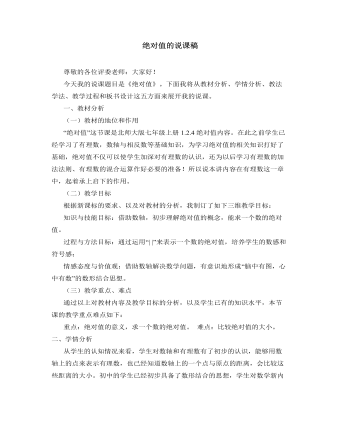
北师大初中数学七年级上册绝对值的说课稿
(三)学以致用,巩固新知为巩固本节的教学重点我再次给出三道问题: 1)绝对值是7的数有几个?各是什么?有没有绝对值是-2的数?2)绝对值是0的数有几个?各是什么? 3)绝对值小于3的整数一共有多少个?先让学生通过小组讨论得出结果,通过以上练习使学生在掌握知识的基础上达到灵活运用,形成一定的能力。(四)总结归纳,知识升华小结时我也将充分发挥学生学习的主动性,发挥教师在教学的启发引导作用,和学生一起合作把本节课所学的内容做一个小结。(五)布置作业,拓展新知布置作业不是目的,目的是使学生能够更好地掌握并运用本节课的内容。所以我会布置这样一个作业:请学生回家在父母的帮助下,找出南方和北方各三个城市的温度,并比较这些温度的大小,并写出每个温度的绝对值进行比较
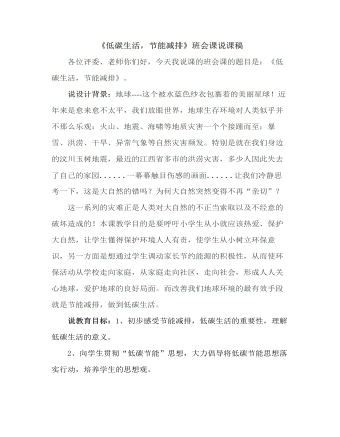
《低碳生活,节能减排》班会课说课稿
说活动重点和难点:理解低碳节能的意义,使学生低碳节能的思想落实到行动。说活动准备:教师制作课件说活动形式:课件展示、讲事例、讨论等说活动过程:第一环节:体验低碳节能的必要性课件展示:冰川的融化,珍惜动植物的减少,汶川、玉树地震后的景象以及抚州水灾图。[ 设计意图 ] 思想教育是对人内心的感化,因为学生都是有血有肉、有情有感的活生生的人,欲先动其心,必先动其情,先要在情感上引起学生的共鸣,才能收到良好的教育效果,为下面低碳节能作铺垫。第二环节:领悟低碳节能的涵义师:看完前面的画面,同学们有什么感想呢?(让学生自由发言说说自己的想法,感受)教师补充:同学们都说的非常好,其实造成这样的一些灾害跟我们人类是有很大关系的,因为我们人类不懂得保护环境而造成了那么多的灾难,那请问我们要不要做一个环保小使者呢?
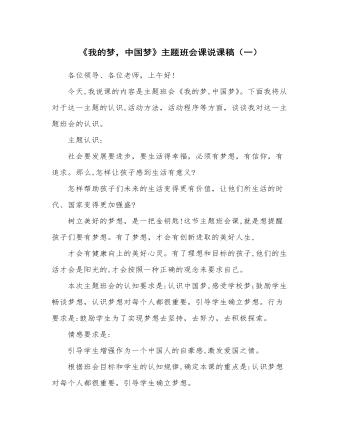
《我的梦,中国梦》主题班会课说课稿(1)
第一个板块:观看视频,导入主题首先播放“我的梦中国梦”公益节目视频,让学生通过观看视频认识梦想,感受到梦想的重要性。然后在歌曲《梦想》的旋律中引出课题。这种以视频创设情境的导课方式,可以抓住学生的注意力,激发学生的好奇心,启发学生的想象力,使学生产生浓厚的兴趣。第二个板块:识“梦”1、畅谈”我的梦”在这一环节我设计了这样的问题:你的梦想是什么?学生畅所欲言。谈论自己的梦想是学生们所喜欢的,这样可以激起学生的学习兴趣,调动他们参与交流的积极性,从而让他们在交流中思考,明确自己的梦想。2、感受“学校梦"首先请学生代表介绍学校举办黄海潮的盛况、校足球运动的开展情况以及校足球队取得的佳绩,通过-个个亲身经历的学校故事,让学生产生情感共鸣,从而感受到:我们的学校也在追梦,在所有老师和学生的艰辛努力下,取得了很多耀眼的成绩。
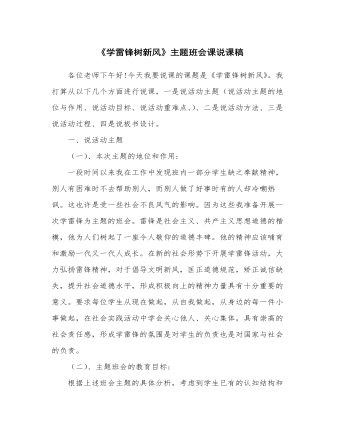
《学雷锋树新风》主题班会课说课稿
2、活动一——雷锋故事会(1)、让同学们展示课前收集的有关雷锋帮助别人的故事。使全体的同学都参与到这个活动中,发挥他们的积极性。(2)、为了丰富教育资源我在此处为学生准备了《可敬的“傻子”》、《雨夜送大嫂》、《人民的勤务员》三个故事,进行补允让学生更加全面的了解雷锋精神。设计此活动的目的是陶冶学生情操,让学生更加深入的了解勤俭朴素、助人为乐、全心全意为人民服务雷锋形象。3、活动二一一读《雷锋日记》让学生读雷锋给一位陌生老人送完手套后写的日记。重点理解“一路上,我的手虽冻得像针扎一样,心中却有一种说不出的愉快。”这一句话。让学生谈谈自己的感受。此活动的目的是让学生了解雷锋的内心世界,理解雷锋精神的实质,全心合意为人民服务。
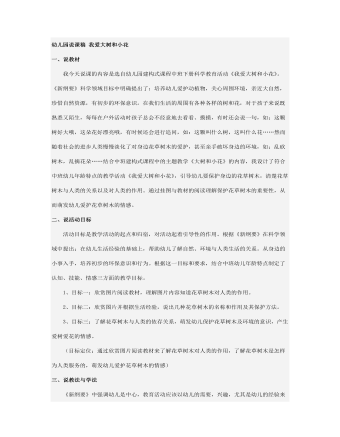
幼儿园说课稿 我爱大树和小花
我今天说课的内容是选自幼儿园建构式课程中班下册科学教育活动《我爱大树和小花》。《新纲要》科学领域目标中明确提出了:培养幼儿爱护动植物,关心周围环境,亲近大自然,珍惜自然资源,有初步的环保意识。在我们生活的周围有各种各样的树和花,对于孩子来说既熟悉又陌生,每每在户外活动时孩子总会不经意地去看看、摸摸,有时还会说一句,如:这颗树好大哦,这朵花好漂亮哦,有时候还会进行追问,如:这颗叫什么树,这叫什么花……然而随着社会的进步人类慢慢淡化了对身边花草树木的爱护,甚至亲手破坏身边的环境,如:乱砍树木,乱摘花朵……结合中班建构式课程中的主题教学《大树和小花》的内容,我设计了符合中班幼儿年龄特点的教学活动《我爱大树和小花》,引导幼儿要保护身边的花草树木,清楚花草树木与人类的关系以及对人类的作用。通过挂图与教材的阅读理解保护花草树木的重要性,从而萌发幼儿爱护花草树木的情感。
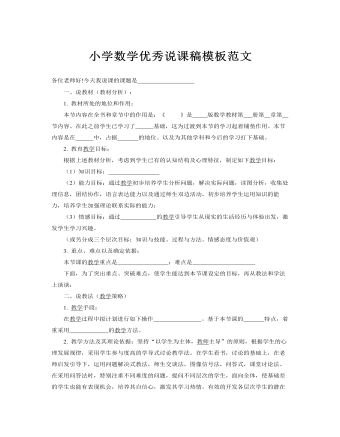
小学数学优秀说课稿模板范文
一、说教材(教材分析): 1. 教材所处的地位和作用: 本节内容在全书和章节中的作用是:《 》是 版数学教材第 册第 章第 节内容。在此之前学生已学习了 基础,这为过渡到本节的学习起着铺垫作用。本节内容是在 中,占据 的地位。以及为其他学科和今后的学习打下基础。2. 教育教学目标: 根据上述教材分析,考虑到学生已有的认知结构及心理特征,制定如下教学目标: (1)知识目标: (2)能力目标:通过教学初步培养学生分析问题,解决实际问题,读图分析,收集处理信息,团结协作,语言表达能力以及通过师生双边活动,初步培养学生运用知识的能力,培养学生加强理论联系实际的能力;
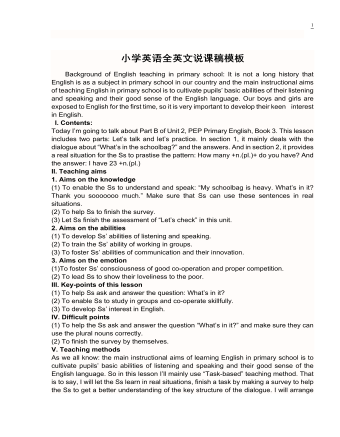
小学英语全英文说课稿模板
1. Aims on the knowledge(1) To enable the Ss tounderstand and speak: “My schoolbag is heavy. What’s in it? Thank you sooooooomuch.” Make sure that Ss can use these sentences in real situations.(2) To help Ss to finish thesurvey.(3) Let Ss finish theassessment of “Let’s check” in this unit.2. Aims on the abilities(1) To develop Ss’ abilitiesof listening and speaking.(2) To train the Ss’ abilityof working in groups.(3) To foster Ss’ abilities ofcommunication and their innovation. 3. Aims on the emotion(1)To foster Ss’ consciousnessof good co-operation and proper competition.(2) To lead Ss to show theirloveliness to the poor.
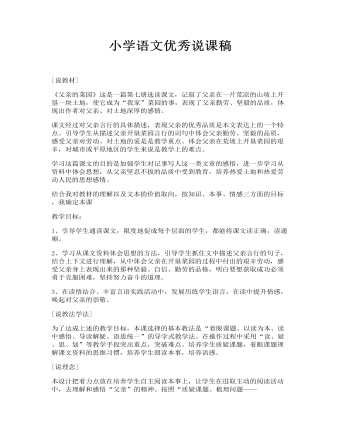
小学语文优秀说课稿 (优选10篇)
教学目标:1、引导学生通读课文,限度地促成每个层面的学生,都能将课文读正确,读通顺。2、学习从课文资料体会思想的方法,引导学生抓住文中描述父亲言行的句子,结合上下文进行理解,从中体会父亲在开垦菜园的过程中付出的艰辛劳动,感受父亲身上表现出来的那种坚毅、自信、勤劳的品格,明白要想获取成功必须勇于克服困难,坚持努力奋斗的道理。3、在读悟结合、丰富言语实践活动中,发展历练学生语言,在读中提升情感,唤起对父亲的崇敬。[说教法学法]为了达成上述的教学目标,本课选择的基本教法是“着眼课题、以读为本、读中感悟、导读解疑、语思统一”的导学式教学法。在操作过程中采用“读、疑、思、划”等教学手段突出重点,突破难点。培养学生质疑课题,着眼课题理解课文资料的思维习惯,培养学生朗读本事,培养语感。
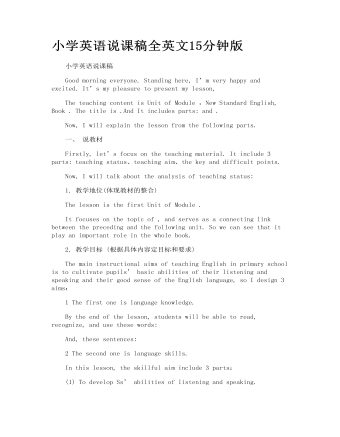
小学英语说课稿全英文15分钟版
一、 说教材 Firstly, let’s focus on theteaching material. It include 3 parts: teaching status、teachingaim、the key and difficult points. Now, I will talk about the analysis of teaching status: 1. 教学地位(体现教材的整合) The lesson is the first Unit of Module . It focuses on the topic of , and serves as a connectinglink between the preceding and the following unit. So we can see that it playan important role in the whole book. 2. 教学目标 (根据具体内容定目标和要求) The main instructional aims of teaching English inprimary school is to cultivate pupils’ basic abilitiesof their listening and speaking and their good sense of the English language,so I design 3 aims:
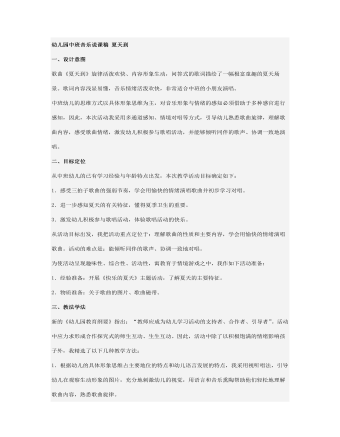
幼儿园中班音乐说课稿 夏天到
新的《幼儿园教育纲要》指出:“教师应成为幼儿学习活动的支持者、合作者、引导者”。活动中应力求形成合作探究式的师生互动、生生互动。因此,活动中除了以积极饱满的情绪影响孩子外,我精选了以下几种教学方法:1.根据幼儿的具体形象思维占主要地位的特点和幼儿语言发展的特点,我采用视听唱法,引导幼儿在观察生动形象的图片,充分地刺激幼儿的视觉,用语言和音乐熏陶帮助他们轻松地理解歌曲内容,熟悉歌曲旋律。2.根据“先行组织者理论”,采用难点前置的方法,引导幼儿感知歌曲的强弱节奏,并分段学唱。从幼儿熟悉的雷声、蛙声入手,引导幼儿感受三拍子的强弱节奏,同时熟悉歌曲旋律,学唱歌曲。3.根据幼儿活泼好动的年龄特点,采用游戏对唱的方式,引导幼儿倾听同伴的歌声,学习协调一致地进行演唱。教学活动是老师和幼儿共同表演的舞台,而幼儿是学习活动的主体,教师的“表演”以及活动中所呈现的一切都必须为孩子自然的学习服务。因此,我在本次活动中注重幼儿自身的学习和体验,采用体验学习法和多种感官参与法,引导幼儿在体验中学习,通过想一想、说一说、看一看、听一听、学一学、唱一唱等多种感官的活动,学习演唱歌曲。
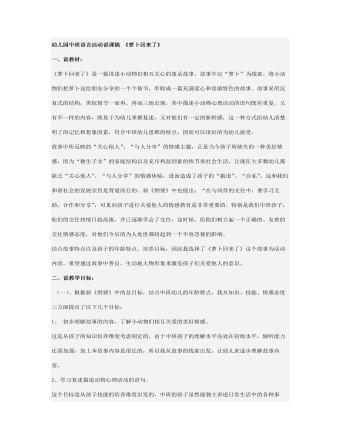
幼儿园中班语言活动说课稿
《萝卜回来了》是一篇讲述小动物们相互关心的童话故事,故事中以“萝卜”为线索,将小动物们把萝卜送给朋友分享的一个个情节,串联成一篇充满爱心和喜剧特色的故事。故事采用反复式的结构,类似情节一而再、再而三地出现,其中描述小动物心理活动的语句既有重复,又有不一样的内容,既易于为幼儿掌握复述,又对他们有一定的新鲜感,这一种方式给幼儿清楚明了的记忆和想象因素,符合中班幼儿思维的特点,因而可以很好的为幼儿接受。故事中所反映的“关心他人”、“与人分享”的情感主题,正是当今孩子所缺失的一种美好情感,因为“独生子女”的家庭结构以及充斥利益因素的快节奏社会生活,让现在大多数幼儿都缺乏“关心他人”、“与人分享”的情感体验,进而造成了孩子的“霸道”、“自私”,这和我们和谐社会的发展宗旨是背道而行的。新《纲要》中也提出:“在与同伴的交往中,要学习互助、合作和分享”,可见向孩子进行关爱他人的情感教育是非常重要的。特别是我们中班孩子,他们的交往热情日趋高涨,并已逐渐学会了交往,这时候,给他们树立起一个正确的、友善的交往情感态度,对他们今后的为人处世都将起到一个不容忽视的影响。